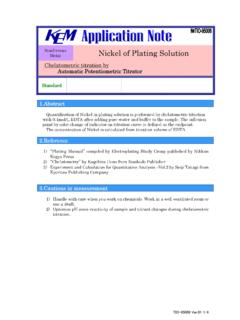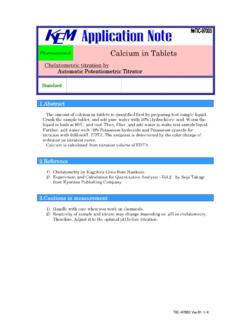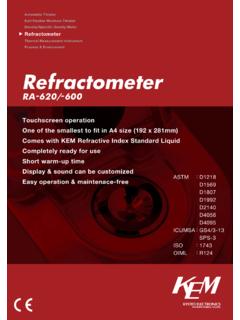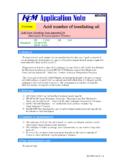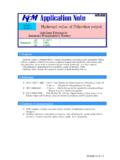Transcription of 09/26/2011 GHS-0057E SAFETY DATA SHEET - …
1 09/26/2011 GHS- 0057e 1/10 GHS- 0057e SAFETY data SHEET PRODUCT NAME Ethanol data of issue 01/30/2012 5%, 10%, 15%, 20%, 25%, 30%, 35%, 40% 45%, 50%, Date of revision - 55%, 60%, 65%, 70%, 75%, 80%, 85%, 90%, 95%, 100% Identification of the substance or mixture and the supplier Product name: Ethanol 5%, 10%, 15%, 20%, 25%, 30%, 35%, 40% 45%, 50%, 55%, 60%, 65%, 70%, 75%, 80%, 85%, 90%, 95%, 100% Name of supplier: Kyoto Electronics Manufacturing Co., Ltd. Address: 68 Ninodan-cho, Shinden, Kisshoin, Minami-ku, Kyoto, Japan Division: Quality Assurance Department Phone: +81-75-691-4121 Fax: +81-75-691-4127 Emergency phone No.
2 : +81-75-691-4125 MSDS No. GHS- 0057e Hazard identification GHS hazard class and category Physical hazards; Flammable liquids: Category 2 Health hazards; Eye damage/irritation: Category 2A-2B Germ cell mutagenicity Category 1B Toxic to reproduction Category 1A Specific target organ systemic toxicity (single exposure): Category 3 (Respiratory tract irritation, Narcotic effects) Specific target organ systemic toxicity (repeated exposure): Category 1 (Liver) Category 2 (Central nervous system) Other hazard identification are not shown above because of the reasons below.
3 Not applicable / Classification not possible Label elements Pictogram Signal word Danger 09/26/2011 GHS- 0057e 2/10 Hazard statements Highly flammable liquid and vapour Causes serious eye irritation May cause genetic defects May damage fertility or the unborn child May cause harm to breast-fed children May cause respiratory irritation; or May cause drowsiness or dizzinessWarning May cause damage to organs through prolonged or repeated exposure (nerve) Precautionary statements Prevention Do not handle until all SAFETY precautions have been read and understood.
4 Keep away from ignition sources such as heat/sparks/open flames/ - No smoking. Do not eat, drink or smoke when using this product. Keep container tightly closed. Use explosion- proof equipment. Take precautionary measures against static discharge. Ground/bond container and receiving equipment. In case of inadequate ventilation wear respiratory protection. Contaminated work clothing should not be allowed out of the workplace. Wear protective gloves and eye/face protection. Do not breathe dust/fume/gas/mist/vapours/spray. Response Avoid contact during pregnancy/while nursing.
5 Use only outdoors or in a well-ventilated area. Wash hands thoroughly after handling. In case of fire, use for extinction appropriate media - if water increases risk. IF IN EYES: Rinse cautiously with water for several minutes. Remove contact lenses, if present and easy to do. Continue rinsing. If eye irritation persists, get medical advice/attention. IF INHALED: Remove victim to fresh air and keep at rest in a position comfortable for breathing. IF ON SKIN: Wash with plenty of soap and water. If skin irritation occurs, seek medical advice/attention.
6 IF exposed: Call a POISON CENTER or doctor/physician. Call a POISON CENTER or doctor/physician if you feel unwell. Collect spillage. Storage Store locked up. Store container tightly closed in cool well-ventilated place. Disposal Dispose of contents and container in accordance with regulation. Composition/Information on ingredients Substance/Mixture: Mixture Chemical identity (or common name): Ethanol Ingredient name Composition % Chemical formulaCAS No. Ethanol -* C2H5OH 64-17-5 09/26/2011 GHS- 0057e 3/10 *Content of brix are; 5%, 10%, 15%, 20%, 25%, 30%, 35%, 40% 45%, 50%, 55%, 60%, 65%, 70%, 75%, 80%, 85%, 90%, 95%, 100% Impurities and stabilizing additives which are themselves classified and which contribute to the classification of the substance; None First-aid measures General description of necessary first aid measures: Emergency Response Guidebook Move victim to fresh air.
7 Keep victim warm and quiet. Call emergency medical service. Apply artificial respiration if victim is not breathing. Administer oxygen if breathing is difficult. Remove and isolate contaminated clothing and shoes. In case of contact with substance, immediately flush skin or eyes with running water for at least 20 minutes. Ensure that medical personnel are aware of the material(s) involved, and take precautions to protect themselves. Inhalation: In case of accident by inhalation: remove casualty to fresh air and keep at rest. If breathing is week, irregular or has stopped, open his airway, loosen his collar and belt and administer artificial respiration.
8 Skin contact: Emergency Response Guidebook Wash skin with soap and water. Take off immediately all contaminated clothing. Eye contact: In case of contact with eyes, rinse immediately with plenty of water and seek medical advice. Ingestion: If swallowed, seek medical advice immediately and show this container or label. Rinse mouth with water. Give the person one or two glasses of water, try to get victim to vomit by having the victim touch the back of their with a finger. Do not make an unconscious person vomit. Most important symptoms/effects, acute and delayed: Inhalation: Cough Headache Fatigue Drowsiness Skin: Dry skin Eyes: Redness Pain Burning Ingestion: Burning sensation Headache Confusion Dizziness Unconsciousness Protections for first-aid persons: Protect yourself by wearing rubber gloves and air-tight SAFETY goggles.
9 Information for the physician: (Ethanol) ACGIH 2004 Irritation Fire-fighting measures 09/26/2011 GHS- 0057e 4/10 Extinguishing media: Emergency Response Guidebook CAUTION: All these products have a very low flash point. Use of water spray when fighting fire may be inefficient. In case of fire, use water mist, water in large amounts, water resistant form, dry powder, carbon dioxide, and dry sand. Use extinguishing media appropriate to surrounding fire conditions. Incompatible extinguishing media: Do not use (normal) foam extinguisher on this material.
10 Specific hazards arising from the chemical (and with regard to fire-fighting measures): Emergency Response Guidebook Fire may produce irritating, corrosive and/or toxic gases. Run off from fire control or dilution water may cause pollution. Toxic gases will form upon combustion of: carbon monoxide Specific fire-fighting measures: Move containers from fire area if it can be done without risk, if not possible, apply water from a safe distance to cool and protect surrounding area. Dry chemical powder or dry sand should be used for small fires.
